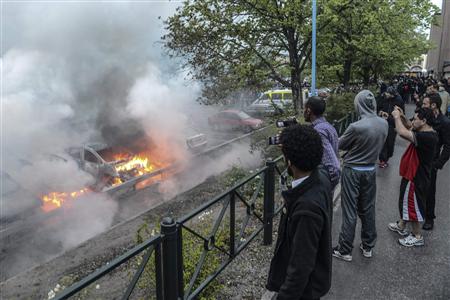Swedish Angst
"In the beginning it was just a bit of fun. But then when I saw the police charging through here with batons, pushing women and children out of the way and swinging their batons, I got so damned angry."
A 20-year-old Swedish-Muslim immigrant, one of a group of 40
His idea of fun was the law and order brigade's signal of society running amok. Torching a line of vehicles might seem like excitement and appeal to the restless sensibilities of the societally disaffected, but it does represent violence, vandalism, lack of respect for the social contract, juvenile arrested development, and most obviously a wish to do harm to others. Proving little other than uneducated and unemployed youth have an under-developed conscience.

Stockholm has seen an uninterrupted six nights of riots, with gangs of roaming youth provoking police by their incendiary alerts to the presence of thugs. The riots that grew out of protests in London and Paris over the years are now manifesting again in Sweden. Residents of the immigrant neighbourhoods of Stockholm speak of a reaction to disappointed employment opportunities, police harassment, a diminished aura of opportunities belying Sweden's open, tolerant reputation.
A staggering 15% of the country's population represents immigrants. In some areas immigrants from Syria, Afghanistan, Somalia predominate. The situation of culture acclimatization is one issue; that of religion-inspired controversy another.The presence of such a large number of socially-destabilizing immigrants has brought a backlash with a centre-right government in power. The country's prime ministers peaks of the rioters as hooligans. They certainly are not respectful supplicants.
While a majority of Swedes still welcome the presence of immigrants, the tide appears to be turning, and little wonder. Sweden is known for its treatment of generosity, greeting new arrivals with housing, language lessons and other encouragements. Predictably, the left-leaning academic take finds fault with the country, not its immigrants: "Those who, for whatever reason, don't have work have not taken part in the general rise in prosperity", intoned a political science professor at Gothenburg University.
Asylum seekers add a financial burden on a welfare state. According to OECD data, foreign-born unemployed rates stand at 16%, in comparison to the native Swedish unemployment rate of 6%. Without a high employment level paying their share of taxes,the welfare system suffers in lack of adequate available funding. This represents the funding performance failure of reality. Swedes do not appreciate the prospect of their welfare state collapsing from overuse and underfunding.
These have been organized riots; representing the prospect of fun for the rioters, serious criminal business for society and its police. Cars are set on fire close by pedestrian bridges. As soon as police and emergency services arrive youths hurl stones. Locals living in Husby where most of the unrest has occurred claim to have been taunted by police. Police also consider the rioters to be comprised of youth gangs and criminals.
Youth complain once they have earned a conviction for possession of drugs, it appears on their records diminishing their opportunity to find employment. Education is not big with many immigrants. The immigrants claim to be discriminated against in one of the Nordic countries that prides itself on its open-minded generosity to the foreigners among them. Over 43,000 asylum seekers were received in 2012, about half of them from Syria, Afghanistan and Somalia.
"Young people wound each other up and started a small fire. I saw how the police came and treated them. I was in shock. I was there and saw it happen. I wasn't struck, but I did have a dog come at me. A police dog isn't a nice little puppy", said a 20-year-old beautician who was interviewed for the news. Perspective from one side, that is perception.
Another perspective is that of first-responders who arrive at the scene of a deliberately set fire at a nursery, a school, a medical building, and bystanders refuse to allow them to attend to the fire, taunting their intent, attacking them. It's clear enough how perspectives differ, how positions harden, how the fault is always found elsewhere.
Labels: Controversy, Crime, Human Relations, Immigration, Social-Cultural Deviations, Sweden

<< Home